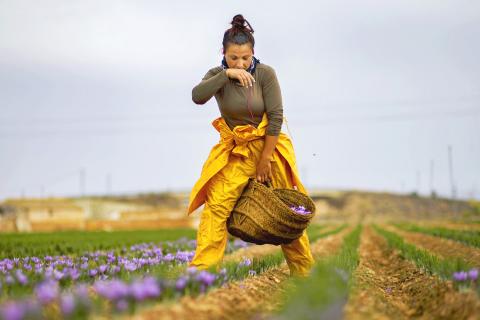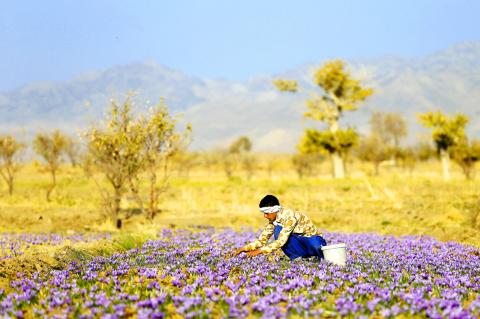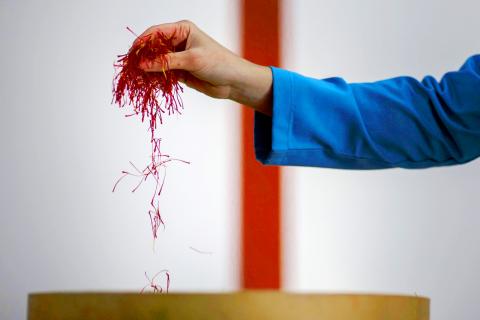On the arid, wind-swept plateau of central Spain, saffron producers are reaping the benefits of a return to favor of the precious spice introduced by Arabs in the Middle Ages.
After a lull in production due to the high cost of growing saffron in Spain, farmers are now back in business, as customers have started seeking quality over lower prices.
Sitting around three long tables at the Molineta company in Minaya, a 1,600-strong village 200km southeast of Madrid, elderly ladies extract bright red stigmas from violet saffron crocuses that will subsequently be dried and sold off.

Photo: AFP
Every day during the autumn harvest, Segunda Gascon, 78, blackens her fingers as she works the fragrant petals, a gesture she has practiced again and again since 1964 when she was given a small batch of seedlings for her wedding.
She is part of a group of about 50 people — many of them retired — who are paid to help out at this time of year in the small village of the Castilla-La Mancha region.
Nearby, Dolores Navarro, 83, sings a folk song as she works: “The saffron rose is a fragrant flower, that grows at sunrise and dies at sunset.”

Photo: AP
She remembers the men who would come to the village in the 1960s to buy the spice “at a high price.”
But then came the modernization of agriculture, which led to a drop in many food prices.
Saffron though, which relies on intensive manual labor, remained expensive and Spanish producers were unable to keep up.

Photo: AFP
From more than 100 tonnes a year at the start of the 20th century, Spanish production dropped over the decades to just 1.9 tonnes in 2014, the last official figure.
By comparison Iran — where the workforce is cheaper and the selection of stigmas less strict — says 93 percent of worldwide saffron production came from the country last year, at 350 tonnes.
Spain, Morocco and Kashmir shared what was left.
“In the 1980s, saffron was ruinous,” said Molineta founder Juan Antonio Ortiz, a 66-year-old farmer.
Standing by his field, he keeps an eye on the basket-carrying Bulgarian, Senegalese and Malian day workers, who have been picking still-closed flowers since daybreak and are paid 5.20 euros (US$5.49) a kilo.
Unlike others, Ortiz decided not to abandon his precious flowers, and it eventually paid off.
His 10 hectares of saffron now earn his family “around 500 euros per kilo,” which comes to about 50,000 euros a year.
“I held on because I always liked growing this,” he said.
“I was barely walking and I was already in the saffron plots with my mother picking the flowers,” he said.
At the turn of the century, Ortiz and his wife, Maria Angeles, bet on quality to broaden their production, which now comes complete with a protected designation of origin (PDO) label recognized by the EU.
They sell their saffron to distributors from Spain, the US, European countries and even the United Arab Emirates.
Once Maria Angeles has sorted through the stigmas with tweezers, and dried them on a silk canvas above a small fire, she puts them in small plastic bags to wait for experts who control their composition to give them their PDO.
They will then be able to sell the saffron threads with their distinctive aroma.
The price? Four euros per gram.
Spanish saffron is “among the best of anywhere,” said Pat Heslop-Harrison, professor of agricultural biology at Britain’s Leicester University.
“Castilla-La Mancha has the perfect conditions,” he said, pointing to “the types of soil, climate, how it is harvested and dried.”
That fact has not gone unnoticed among Spain’s legion of chefs.
“In Spain, we treat it as if it were threads of gold,” said Daniel Lasa, chef at Spain’s Michelin-starred Mugaritz restaurant.
“La Mancha’s saffron is much clearer, less bitter” than that of Iran, he added.
He prefers using the spice for soups and gelatines, and to accompany seafood.
In the region around Minaya, Spain’s devastating economic crisis, which erupted in 2008, pushed many to return to growing what is known as “red gold.”
There are now 267 producers of saffron with the PDO label alone in Spain. Just 100km away in Toledo, where unemployment is sky-high, small-scale producers are on the rise, grouping themselves into cooperatives.
And in Minaya, the Ortiz family is no longer alone.
Antonio Garcia Filoso, 36, started planting saffron two years ago, and produced 3kg last year.

With an approval rating of just two percent, Peruvian President Dina Boluarte might be the world’s most unpopular leader, according to pollsters. Protests greeted her rise to power 29 months ago, and have marked her entire term — joined by assorted scandals, investigations, controversies and a surge in gang violence. The 63-year-old is the target of a dozen probes, including for her alleged failure to declare gifts of luxury jewels and watches, a scandal inevitably dubbed “Rolexgate.” She is also under the microscope for a two-week undeclared absence for nose surgery — which she insists was medical, not cosmetic — and is

CAUTIOUS RECOVERY: While the manufacturing sector returned to growth amid the US-China trade truce, firms remain wary as uncertainty clouds the outlook, the CIER said The local manufacturing sector returned to expansion last month, as the official purchasing managers’ index (PMI) rose 2.1 points to 51.0, driven by a temporary easing in US-China trade tensions, the Chung-Hua Institution for Economic Research (CIER, 中華經濟研究院) said yesterday. The PMI gauges the health of the manufacturing industry, with readings above 50 indicating expansion and those below 50 signaling contraction. “Firms are not as pessimistic as they were in April, but they remain far from optimistic,” CIER president Lien Hsien-ming (連賢明) said at a news conference. The full impact of US tariff decisions is unlikely to become clear until later this month

GROWING CONCERN: Some senior Trump administration officials opposed the UAE expansion over fears that another TSMC project could jeopardize its US investment Taiwan Semiconductor Manufacturing Co (TSMC, 台積電) is evaluating building an advanced production facility in the United Arab Emirates (UAE) and has discussed the possibility with officials in US President Donald Trump’s administration, people familiar with the matter said, in a potentially major bet on the Middle East that would only come to fruition with Washington’s approval. The company has had multiple meetings in the past few months with US Special Envoy to the Middle East Steve Witkoff and officials from MGX, an influential investment vehicle overseen by the UAE president’s brother, the people said. The conversations are a continuation of talks that

CHIP DUTIES: TSMC said it voiced its concerns to Washington about tariffs, telling the US commerce department that it wants ‘fair treatment’ to protect its competitiveness Taiwan Semiconductor Manufacturing Co (TSMC, 台積電) yesterday reiterated robust business prospects for this year as strong artificial intelligence (AI) chip demand from Nvidia Corp and other customers would absorb the impacts of US tariffs. “The impact of tariffs would be indirect, as the custom tax is the importers’ responsibility, not the exporters,” TSMC chairman and chief executive officer C.C. Wei (魏哲家) said at the chipmaker’s annual shareholders’ meeting in Hsinchu City. TSMC’s business could be affected if people become reluctant to buy electronics due to inflated prices, Wei said. In addition, the chipmaker has voiced its concern to the US Department of Commerce